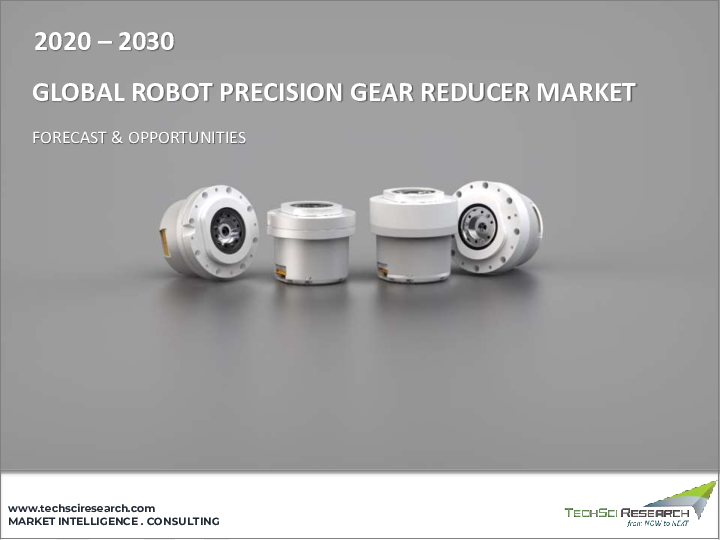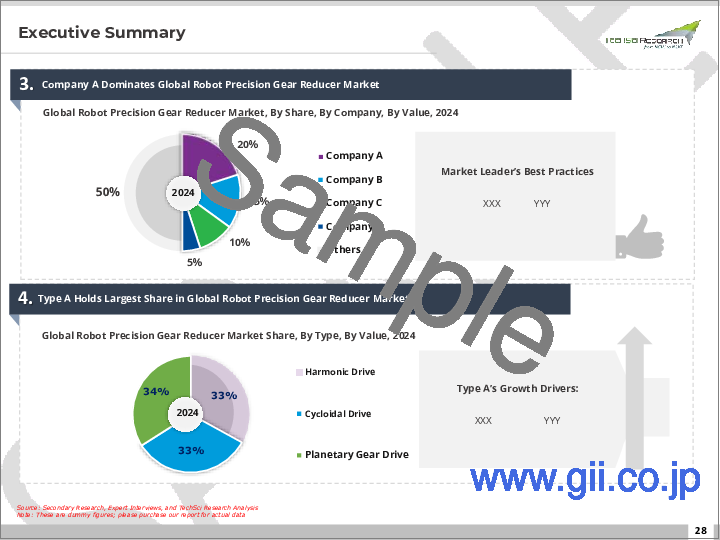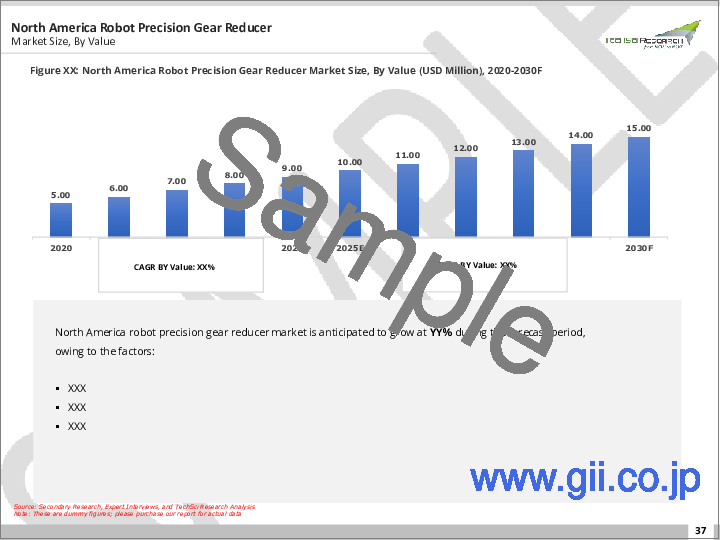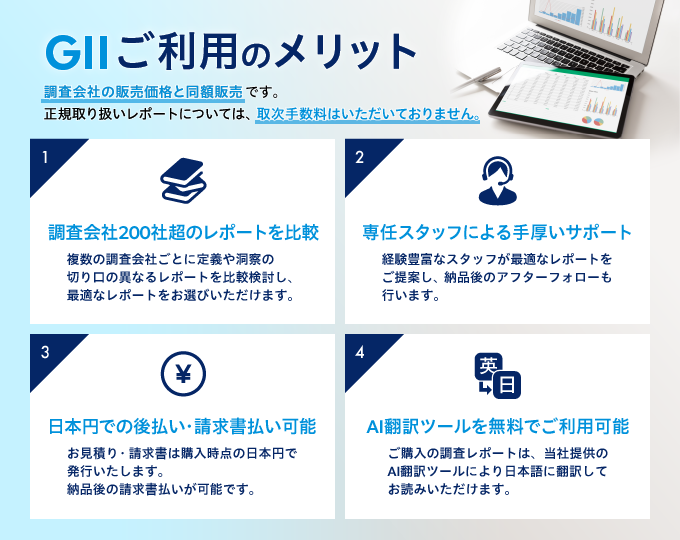|
|
市場調査レポート
商品コード
1779138
ロボット用精密ギヤ減速機市場 - 世界の産業規模、シェア、動向、機会、予測:タイプ別、アプリケーション別、地域別、競合、2020年~2030年Robot Precision Gear Reducer Market - Global Industry Size, Share, Trends, Opportunity, and Forecast, Segmented By Type, By Application, By Region, By Competition, 2020-2030F |
||||||
カスタマイズ可能
|
|||||||
| ロボット用精密ギヤ減速機市場 - 世界の産業規模、シェア、動向、機会、予測:タイプ別、アプリケーション別、地域別、競合、2020年~2030年 |
|
出版日: 2025年07月29日
発行: TechSci Research
ページ情報: 英文 188 Pages
納期: 2~3営業日
|
全表示
- 概要
- 目次
ロボット用精密ギヤ減速機の世界市場規模は2024年に19億米ドル、2030年までのCAGRは8.3%で2030年には31億米ドルに達すると予測されています。
ロボット用精密ギヤ減速機の世界市場は、主に製造、物流、ヘルスケア、eコマースなどの多様な分野における産業オートメーションとロボティクスの急速な導入が原動力となっています。産業界がより高い効率と精度を追求する中、精密ギヤ減速機は、組立、溶接、包装などのロボット用途で精密なモーションコントロールを可能にするための不可欠な部品となっています。協働ロボット(cobot)の台頭は、人間と一緒に安全に動作するために、コンパクトでバックラッシュがなく、信頼性の高い減速機を必要とし、市場の成長をさらに促進しています。
| 市場概要 | |
|---|---|
| 予測期間 | 2026-2030 |
| 市場規模:2024年 | 19億米ドル |
| 市場規模:2030年 | 31億米ドル |
| CAGR:2025年~2030年 | 8.3% |
| 急成長セグメント | ハーモニックドライブ |
| 最大市場 | 北米 |
軽量・高強度材料の使用、リアルタイム監視と予知保全のためのIoTとAIの統合などの技術進歩により、減速機の性能と魅力が大幅に向上しています。エネルギー効率と持続可能性が重視されるようになり、エネルギー損失を最小限に抑え、環境に優しい製造プロセスをサポートする減速機への需要が高まっています。地域的には、急速な工業化と自動化を推進する政府の取り組みにより、アジア太平洋地域が成長をリードしており、ラテンアメリカ、中東、東南アジアの新興市場も急速に拡大しています。さらに、インダストリー4.0とスマート工場に向けた動向が、インテリジェントなセンサー内蔵減速機の需要を押し上げています。最後に、航空宇宙、医療機器、電気自動車への分野の多様化は、市場の範囲を広げ、ロボット用精密ギヤ減速機の着実な世界的成長を強化しています。
主な市場促進要因
産業オートメーションとロボット工学の急速な普及
主な市場課題
高い生産コストと複雑な製造プロセス
主な市場動向
スマートテクノロジーの統合とインダストリー4.0の互換性
目次
第1章 概要
第2章 調査手法
第3章 エグゼクティブサマリー
第4章 顧客の声
第5章 世界のロボット用精密ギヤ減速機市場展望
- 市場規模・予測
- 金額別
- 市場シェア・予測
- タイプ別(ハーモニックドライブ、サイクロイドドライブ、遊星ギヤドライブ)
- アプリケーション別(自動車、エレクトロニクス、金属・機械、食品・飲料、その他)
- 地域別(北米、欧州、南米、中東・アフリカ、アジア太平洋)
- 企業別(2024)
- 市場マップ
第6章 北米のロボット用精密ギヤ減速機市場展望
- 市場規模・予測
- 市場シェア・予測
- 北米:国別分析
- 米国
- カナダ
- メキシコ
第7章 欧州のロボット用精密ギヤ減速機市場展望
- 市場規模・予測
- 市場シェア・予測
- 欧州:国別分析
- ドイツ
- フランス
- 英国
- イタリア
- スペイン
第8章 アジア太平洋地域のロボット用精密ギヤ減速機市場展望
- 市場規模・予測
- 市場シェア・予測
- アジア太平洋地域:国別分析
- 中国
- インド
- 日本
- 韓国
- オーストラリア
第9章 中東・アフリカのロボット用精密ギヤ減速機市場展望
- 市場規模・予測
- 市場シェア・予測
- 中東・アフリカ:国別分析
- サウジアラビア
- アラブ首長国連邦
- 南アフリカ
第10章 南米のロボット用精密ギヤ減速機市場展望
- 市場規模・予測
- 市場シェア・予測
- 南米:国別分析
- ブラジル
- コロンビア
- アルゼンチン
第11章 市場力学
- 促進要因
- 課題
第12章 市場動向と発展
- 合併と買収
- 製品上市
- 最近の動向
第13章 企業プロファイル
- Harmonic Drive Systems Inc.
- Nabtesco Corporation
- Sumitomo Heavy Industries, Ltd.
- SEW-Eurodrive GmbH & Co KG
- Rexnord Corporation
- Bosch Rexroth AG
- Neugart GmbH
- Wittenstein SE
第14章 戦略的提言
第15章 調査会社について・免責事項
The Global Robot Precision Gear Reducer Market was valued at USD 1.9 billion in 2024 and is expected to reach USD 3.1 billion by 2030 with a CAGR of 8.3% through 2030. The global Robot Precision Gear Reducer market is primarily driven by the rapid adoption of industrial automation and robotics across diverse sectors such as manufacturing, logistics, healthcare, and e-commerce. As industries strive for higher efficiency and accuracy, precision gear reducers become essential components for enabling precise motion control in robotic applications like assembly, welding, and packaging. The rise of collaborative robots (cobots), which require compact, backlash-free, and highly reliable reducers to operate safely alongside humans, further fuels market growth.
| Market Overview | |
|---|---|
| Forecast Period | 2026-2030 |
| Market Size 2024 | USD 1.9 Billion |
| Market Size 2030 | USD 3.1 Billion |
| CAGR 2025-2030 | 8.3% |
| Fastest Growing Segment | Harmonic Drive |
| Largest Market | North America |
Technological advancements, including the use of lightweight, high-strength materials and integration of IoT and AI for real-time monitoring and predictive maintenance, significantly enhance reducer performance and appeal. Increasing emphasis on energy efficiency and sustainability drives demand for reducers that minimize energy losses and support eco-friendly manufacturing processes. Geographically, the Asia-Pacific region leads growth due to rapid industrialization and government initiatives promoting automation, while emerging markets in Latin America, the Middle East, and Southeast Asia are also expanding rapidly. Additionally, the trend towards Industry 4.0 and smart factories boosts demand for intelligent, sensor-embedded reducers. Finally, sector diversification into aerospace, medical devices, and electric vehicles broadens the market scope, reinforcing the steady global growth of robot precision gear reducers.
Key Market Drivers
Rapid Growth of Industrial Automation and Robotics Adoption
One of the foremost drivers propelling the Global Robot Precision Gear Reducer market is the rapid and widespread adoption of industrial automation and robotics across various sectors. The manufacturing industry, in particular, is undergoing a significant transformation driven by the need to improve productivity, enhance precision, and reduce operational costs. Robot precision gear reducers play a crucial role in enabling the smooth, accurate, and reliable movement of robotic arms and automated machinery, making them indispensable in assembly lines, welding operations, packaging, and inspection tasks.
Globally, industrial robotics sales have witnessed exponential growth over the past decade, fueled by initiatives such as Industry 4.0 and smart manufacturing. Factories are increasingly integrating automated systems to handle complex, repetitive tasks with high precision and minimal error rates. This shift is not limited to large enterprises; small and medium-sized enterprises (SMEs) are also embracing automation to stay competitive. The demand for precision reducers that deliver high torque density, low backlash, and long service life is rising accordingly.
Moreover, the surge in e-commerce and warehousing automation has created a strong market for automated guided vehicles (AGVs) and autonomous mobile robots (AMRs), which rely heavily on precision gear reducers for efficient and accurate motion control. The growing need for flexibility and scalability in production environments encourages the deployment of robots equipped with advanced reducers, capable of handling variable loads and intricate movements.
Additionally, government policies and incentives promoting automation and advanced manufacturing in emerging economies such as China, India, and Southeast Asia are accelerating market growth. These regions are witnessing substantial investments in robotics infrastructure, which directly boosts demand for high-quality precision gear reducers. Collectively, the global push towards digitization, automation, and operational efficiency continues to be a major catalyst driving the growth of the robot precision gear reducer market. Industrial robot installations reached over 600,000 units worldwide in 2024, marking a year-over-year growth of more than 10% . The automotive sector represented nearly 30% of total industrial robot usage globally, followed by electronics and metal industries. Collaborative robots or cobots saw a growth rate of over 15% , with more than 80,000 units deployed globally in 2024. More than 70% of manufacturing facilities in developed markets integrated some form of automation or robotics into operations.
Key Market Challenges
High Production Costs and Complex Manufacturing Processes
One of the primary challenges facing the Global Robot Precision Gear Reducer market is the high production cost associated with manufacturing these highly precise and reliable components. Precision gear reducers require advanced materials, meticulous design, and extremely tight manufacturing tolerances to achieve the necessary accuracy, low backlash, and durability demanded by robotic applications. This complexity increases the cost of production significantly compared to conventional gear systems.
The use of premium materials such as hardened steel alloys, titanium, or carbon fiber composites-while beneficial for performance-adds to raw material costs. Additionally, sophisticated manufacturing techniques like precision grinding, honing, and specialized heat treatment processes are essential to achieve the exact gear tooth profiles and surface finishes required. Such processes are time-consuming and require advanced machinery and skilled labor, all contributing to elevated manufacturing expenses.
Moreover, the integration of embedded sensors and smart technologies for real-time monitoring and predictive maintenance further complicates production and drives costs higher. For manufacturers, investing in R&D and adopting cutting-edge production methods involves substantial capital expenditure, which can be a barrier especially for smaller companies aiming to enter or expand in this market.
Key Market Trends
Integration of Smart Technologies and Industry 4.0 Compatibility
A major trend reshaping the Global Robot Precision Gear Reducer market is the increasing integration of smart technologies, aligning with the broader Industry 4.0 movement. Precision gear reducers are evolving from simple mechanical components into intelligent devices equipped with embedded sensors, connectivity modules, and real-time diagnostic capabilities. This trend enables predictive maintenance, enhanced performance monitoring, and improved operational efficiency.
Smart reducers can collect data on parameters such as temperature, vibration, torque, and load during operation. By leveraging IoT (Internet of Things) technology, this data is transmitted to centralized control systems or cloud platforms where AI algorithms analyze it to predict potential failures before they occur. This minimizes unplanned downtime and extends the service life of robotic systems, crucial for industries that depend on continuous, high-precision operations.
Industry 4.0 compatibility also facilitates seamless integration of gear reducers with advanced robotic systems and automated manufacturing lines. Reducers with embedded sensors support closed-loop control systems, improving motion accuracy and response times. They allow robots to adapt dynamically to varying load conditions and operational changes, thus enhancing overall productivity.
This trend is driven by the growing adoption of smart factories worldwide, where digitalization and automation technologies are transforming traditional manufacturing processes. The demand for connected, intelligent components is rising, particularly in sectors such as automotive, aerospace, electronics, and logistics, where precision and reliability are paramount.
Manufacturers are investing heavily in R&D to develop next-generation precision gear reducers with advanced materials, embedded electronics, and software integration. This convergence of mechanical engineering and digital technology is expected to become a standard feature in the near future, making smart, Industry 4.0-ready gear reducers a key market differentiator.
Key Market Players
- Harmonic Drive Systems Inc.
- Nabtesco Corporation
- Sumitomo Heavy Industries, Ltd.
- SEW-Eurodrive GmbH & Co KG
- Rexnord Corporation
- Bosch Rexroth AG
- Neugart GmbH
- Wittenstein SE
Report Scope:
In this report, the Global Robot Precision Gear Reducer Market has been segmented into the following categories, in addition to the industry trends which have also been detailed below:
Robot Precision Gear Reducer Market, By Type:
- Harmonic Drive
- Cycloidal Drive
- Planetary Gear Drive
Robot Precision Gear Reducer Market, By Application:
- Automotive
- Electronics
- Metal & Machinery
- Food & Beverage
- Others
Robot Precision Gear Reducer Market, By Region:
- North America
- United States
- Canada
- Mexico
- Europe
- Germany
- France
- United Kingdom
- Italy
- Spain
- Asia Pacific
- China
- India
- Japan
- South Korea
- Australia
- South America
- Brazil
- Colombia
- Argentina
- Middle East & Africa
- Saudi Arabia
- UAE
- South Africa
Competitive Landscape
Company Profiles: Detailed analysis of the major companies present in the Global Robot Precision Gear Reducer Market.
Available Customizations:
Global Robot Precision Gear Reducer Market report with the given market data, Tech Sci Research offers customizations according to a company's specific needs. The following customization options are available for the report:
Company Information
- Detailed analysis and profiling of additional market players (up to five).
Table of Contents
1. Product Overview
- 1.1. Market Definition
- 1.2. Scope of the Market
- 1.2.1. Markets Covered
- 1.2.2. Years Considered for Study
- 1.2.3. Key Market Segmentations
2. Research Methodology
- 2.1. Objective of the Study
- 2.2. Baseline Methodology
- 2.3. Key Industry Partners
- 2.4. Major Association and Secondary Sources
- 2.5. Forecasting Methodology
- 2.6. Data Triangulation & Validation
- 2.7. Assumptions and Limitations
3. Executive Summary
- 3.1. Overview of the Market
- 3.2. Overview of Key Market Segmentations
- 3.3. Overview of Key Market Players
- 3.4. Overview of Key Regions/Countries
- 3.5. Overview of Market Drivers, Challenges, and Trends
4. Voice of Customer
5. Global Robot Precision Gear Reducer Market Outlook
- 5.1. Market Size & Forecast
- 5.1.1. By Value
- 5.2. Market Share & Forecast
- 5.2.1. By Type (Harmonic Drive, Cycloidal Drive, Planetary Gear Drive)
- 5.2.2. By Application (Automotive, Electronics, Metal and Machinery, Food and Beverage, Others)
- 5.2.3. By Region (North America, Europe, South America, Middle East & Africa, Asia Pacific)
- 5.3. By Company (2024)
- 5.4. Market Map
6. North America Robot Precision Gear Reducer Market Outlook
- 6.1. Market Size & Forecast
- 6.1.1. By Value
- 6.2. Market Share & Forecast
- 6.2.1. By Type
- 6.2.2. By Application
- 6.2.3. By Country
- 6.3. North America: Country Analysis
- 6.3.1. United States Robot Precision Gear Reducer Market Outlook
- 6.3.1.1. Market Size & Forecast
- 6.3.1.1.1. By Value
- 6.3.1.2. Market Share & Forecast
- 6.3.1.2.1. By Type
- 6.3.1.2.2. By Application
- 6.3.1.1. Market Size & Forecast
- 6.3.2. Canada Robot Precision Gear Reducer Market Outlook
- 6.3.2.1. Market Size & Forecast
- 6.3.2.1.1. By Value
- 6.3.2.2. Market Share & Forecast
- 6.3.2.2.1. By Type
- 6.3.2.2.2. By Application
- 6.3.2.1. Market Size & Forecast
- 6.3.3. Mexico Robot Precision Gear Reducer Market Outlook
- 6.3.3.1. Market Size & Forecast
- 6.3.3.1.1. By Value
- 6.3.3.2. Market Share & Forecast
- 6.3.3.2.1. By Type
- 6.3.3.2.2. By Application
- 6.3.3.1. Market Size & Forecast
- 6.3.1. United States Robot Precision Gear Reducer Market Outlook
7. Europe Robot Precision Gear Reducer Market Outlook
- 7.1. Market Size & Forecast
- 7.1.1. By Value
- 7.2. Market Share & Forecast
- 7.2.1. By Type
- 7.2.2. By Application
- 7.2.3. By Country
- 7.3. Europe: Country Analysis
- 7.3.1. Germany Robot Precision Gear Reducer Market Outlook
- 7.3.1.1. Market Size & Forecast
- 7.3.1.1.1. By Value
- 7.3.1.2. Market Share & Forecast
- 7.3.1.2.1. By Type
- 7.3.1.2.2. By Application
- 7.3.1.1. Market Size & Forecast
- 7.3.2. France Robot Precision Gear Reducer Market Outlook
- 7.3.2.1. Market Size & Forecast
- 7.3.2.1.1. By Value
- 7.3.2.2. Market Share & Forecast
- 7.3.2.2.1. By Type
- 7.3.2.2.2. By Application
- 7.3.2.1. Market Size & Forecast
- 7.3.3. United Kingdom Robot Precision Gear Reducer Market Outlook
- 7.3.3.1. Market Size & Forecast
- 7.3.3.1.1. By Value
- 7.3.3.2. Market Share & Forecast
- 7.3.3.2.1. By Type
- 7.3.3.2.2. By Application
- 7.3.3.1. Market Size & Forecast
- 7.3.4. Italy Robot Precision Gear Reducer Market Outlook
- 7.3.4.1. Market Size & Forecast
- 7.3.4.1.1. By Value
- 7.3.4.2. Market Share & Forecast
- 7.3.4.2.1. By Type
- 7.3.4.2.2. By Application
- 7.3.4.1. Market Size & Forecast
- 7.3.5. Spain Robot Precision Gear Reducer Market Outlook
- 7.3.5.1. Market Size & Forecast
- 7.3.5.1.1. By Value
- 7.3.5.2. Market Share & Forecast
- 7.3.5.2.1. By Type
- 7.3.5.2.2. By Application
- 7.3.5.1. Market Size & Forecast
- 7.3.1. Germany Robot Precision Gear Reducer Market Outlook
8. Asia Pacific Robot Precision Gear Reducer Market Outlook
- 8.1. Market Size & Forecast
- 8.1.1. By Value
- 8.2. Market Share & Forecast
- 8.2.1. By Type
- 8.2.2. By Application
- 8.2.3. By Country
- 8.3. Asia Pacific: Country Analysis
- 8.3.1. China Robot Precision Gear Reducer Market Outlook
- 8.3.1.1. Market Size & Forecast
- 8.3.1.1.1. By Value
- 8.3.1.2. Market Share & Forecast
- 8.3.1.2.1. By Type
- 8.3.1.2.2. By Application
- 8.3.1.1. Market Size & Forecast
- 8.3.2. India Robot Precision Gear Reducer Market Outlook
- 8.3.2.1. Market Size & Forecast
- 8.3.2.1.1. By Value
- 8.3.2.2. Market Share & Forecast
- 8.3.2.2.1. By Type
- 8.3.2.2.2. By Application
- 8.3.2.1. Market Size & Forecast
- 8.3.3. Japan Robot Precision Gear Reducer Market Outlook
- 8.3.3.1. Market Size & Forecast
- 8.3.3.1.1. By Value
- 8.3.3.2. Market Share & Forecast
- 8.3.3.2.1. By Type
- 8.3.3.2.2. By Application
- 8.3.3.1. Market Size & Forecast
- 8.3.4. South Korea Robot Precision Gear Reducer Market Outlook
- 8.3.4.1. Market Size & Forecast
- 8.3.4.1.1. By Value
- 8.3.4.2. Market Share & Forecast
- 8.3.4.2.1. By Type
- 8.3.4.2.2. By Application
- 8.3.4.1. Market Size & Forecast
- 8.3.5. Australia Robot Precision Gear Reducer Market Outlook
- 8.3.5.1. Market Size & Forecast
- 8.3.5.1.1. By Value
- 8.3.5.2. Market Share & Forecast
- 8.3.5.2.1. By Type
- 8.3.5.2.2. By Application
- 8.3.5.1. Market Size & Forecast
- 8.3.1. China Robot Precision Gear Reducer Market Outlook
9. Middle East & Africa Robot Precision Gear Reducer Market Outlook
- 9.1. Market Size & Forecast
- 9.1.1. By Value
- 9.2. Market Share & Forecast
- 9.2.1. By Type
- 9.2.2. By Application
- 9.2.3. By Country
- 9.3. Middle East & Africa: Country Analysis
- 9.3.1. Saudi Arabia Robot Precision Gear Reducer Market Outlook
- 9.3.1.1. Market Size & Forecast
- 9.3.1.1.1. By Value
- 9.3.1.2. Market Share & Forecast
- 9.3.1.2.1. By Type
- 9.3.1.2.2. By Application
- 9.3.1.1. Market Size & Forecast
- 9.3.2. UAE Robot Precision Gear Reducer Market Outlook
- 9.3.2.1. Market Size & Forecast
- 9.3.2.1.1. By Value
- 9.3.2.2. Market Share & Forecast
- 9.3.2.2.1. By Type
- 9.3.2.2.2. By Application
- 9.3.2.1. Market Size & Forecast
- 9.3.3. South Africa Robot Precision Gear Reducer Market Outlook
- 9.3.3.1. Market Size & Forecast
- 9.3.3.1.1. By Value
- 9.3.3.2. Market Share & Forecast
- 9.3.3.2.1. By Type
- 9.3.3.2.2. By Application
- 9.3.3.1. Market Size & Forecast
- 9.3.1. Saudi Arabia Robot Precision Gear Reducer Market Outlook
10. South America Robot Precision Gear Reducer Market Outlook
- 10.1. Market Size & Forecast
- 10.1.1. By Value
- 10.2. Market Share & Forecast
- 10.2.1. By Type
- 10.2.2. By Application
- 10.2.3. By Country
- 10.3. South America: Country Analysis
- 10.3.1. Brazil Robot Precision Gear Reducer Market Outlook
- 10.3.1.1. Market Size & Forecast
- 10.3.1.1.1. By Value
- 10.3.1.2. Market Share & Forecast
- 10.3.1.2.1. By Type
- 10.3.1.2.2. By Application
- 10.3.1.1. Market Size & Forecast
- 10.3.2. Colombia Robot Precision Gear Reducer Market Outlook
- 10.3.2.1. Market Size & Forecast
- 10.3.2.1.1. By Value
- 10.3.2.2. Market Share & Forecast
- 10.3.2.2.1. By Type
- 10.3.2.2.2. By Application
- 10.3.2.1. Market Size & Forecast
- 10.3.3. Argentina Robot Precision Gear Reducer Market Outlook
- 10.3.3.1. Market Size & Forecast
- 10.3.3.1.1. By Value
- 10.3.3.2. Market Share & Forecast
- 10.3.3.2.1. By Type
- 10.3.3.2.2. By Application
- 10.3.3.1. Market Size & Forecast
- 10.3.1. Brazil Robot Precision Gear Reducer Market Outlook
11. Market Dynamics
- 11.1. Drivers
- 11.2. Challenges
12. Market Trends and Developments
- 12.1. Merger & Acquisition (If Any)
- 12.2. Product Launches (If Any)
- 12.3. Recent Developments
13. Company Profiles
- 13.1. Harmonic Drive Systems Inc.
- 13.1.1. Business Overview
- 13.1.2. Key Revenue and Financials
- 13.1.3. Recent Developments
- 13.1.4. Key Personnel
- 13.1.5. Key Product/Services Offered
- 13.2. Nabtesco Corporation
- 13.3. Sumitomo Heavy Industries, Ltd.
- 13.4. SEW-Eurodrive GmbH & Co KG
- 13.5. Rexnord Corporation
- 13.6. Bosch Rexroth AG
- 13.7. Neugart GmbH
- 13.8. Wittenstein SE




